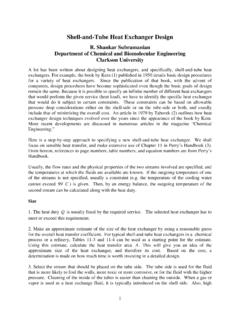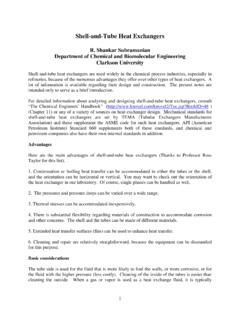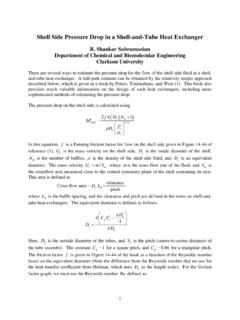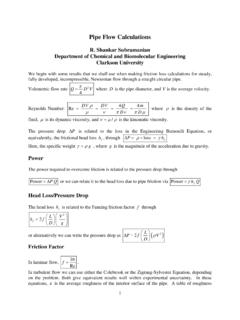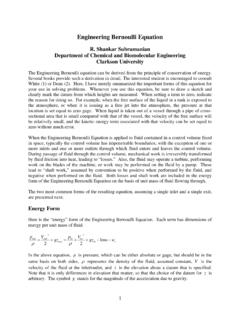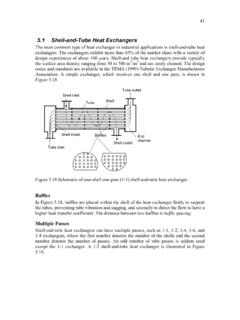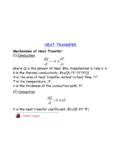Transcription of Heat transfer in Flow Through Conduits
1 heat transfer in Flow Through Conduits R. Shankar Subramanian Department of Chemical and Biomolecular Engineering Clarkson University A common situation encountered by the chemical engineer is heat transfer to fluid flowing Through a tube. This can occur in heat exchangers, boilers, condensers, evaporators, and a host of other process equipment. Therefore, it is useful to know how to estimate heat transfer coefficients in this situation. We can classify the flow of a fluid in a straight circular tube into either laminar or turbulent flow.
2 It is assumed from here on that we assume fully developed incompressible, Newtonian, steady flow conditions. Fully developed flow implies that the tube is long compared with the entrance length in which the velocity distribution at the inlet adjusts itself to the geometry and no longer changes with distance along the tube. Reynolds Number The value of the Reynolds number permits us to determine whether the flow is laminar or turbulent. We define the Reynolds number as follows. DV DV. =. Reynolds number Re =.. Here, D is the inside diameter of the tube (or pipe), V is the average velocity of the fluid, is the density of the fluid and is its dynamic viscosity.
3 It is common to use the kinematic viscosity = / in defining the Reynolds number. Another common form involves using the mass flow rate m instead of the average velocity. The mass flow rate is related to the volumetric . flow rate Q via m = Q , and we can write Q = D 2V . Therefore, the Reynolds number also 4. can be defined as 4Q 4 m . =Re =. D D . The flow in a commercial circular tube or pipe is usually laminar when the Reynolds number is below 2,300. In the range 2,300 < Re < 4, 000 , the status of the flow is in transition and for Re > 4, 000 , flow can be regarded as turbulent.
4 Results for heat transfer in the transition regime are difficult to predict, and it is best to avoid this regime in designing heat exchange equipment. Turbulent flow is inherently unsteady, being characterized by time-dependent fluctuations in the velocity and pressure, but we usually average over these fluctuations and define time-smoothed or time-average velocity and pressure; these time-smoothed entities can be steady or time- 1. dependent (on a time scale much larger than that of the fluctuations), and here we only focus on steady conditions when we discuss either laminar or turbulent flow.
5 Principal differences between heat transfer in laminar flow and that in turbulent flow In discussing heat transfer to or from a fluid flowing Through a straight circular tube, it is useful to distinguish between the axial or main flow direction, and the directions that lie in a plane perpendicular to the tube axis. In that plane, transverse heat flow can be broken into radial and azimuthal components. The principal difference between laminar and turbulent flow, as far as heat transfer is concerned, is that an additional mechanism of heat transfer in the radial and azimuthal directions becomes available in turbulent flow.
6 This is commonly termed eddy transport and is intense, providing much better transfer of energy across the flow at a given axial position than in laminar flow, wherein conduction is typically the only mechanism that operates in the transverse directions (an exception occurs when there are secondary flows in the transverse direction, such as in coiled tubes). Another difference worth noting is the extent of the thermal entrance region in which the transverse temperature distribution becomes fully developed. This region is relatively short in turbulent flow (precisely because of the intense turbulent transverse transport of energy), whereas it tends to be long in laminar flow.
7 heat transfer correlations, based on experimental results, are typically divided into those applicable in the thermal entrance region, and those that apply in the fully developed region. In the case of laminar flow, it is important to be aware of this distinction, and normally a laminar flow heat exchanger is designed to be short, to take advantage of relatively high heat transfer rates that are achievable in the thermal entrance region. In the case of turbulent flow, the thermal entrance region is short, as noted earlier, and typically heat transfer occurs mostly in the fully developed region.
8 Therefore, turbulent heat transfer correlations are commonly provided for the latter region. Laminar heat transfer correlations A variety of correlations are in use for predicting heat transfer rates in laminar flow. From dimensional analysis, the correlations are usually written in the form Nu = ( Re, Pr, ). hD C p . where Nu = is the Nusselt number, is some function, and= Pr = is the Prandtl k k . number. Here, h is the heat transfer coefficient, k is the thermal conductivity of the fluid, and C p is the specific heat of the fluid at constant pressure.
9 As you can see, the Prandtl number can be written as the ratio of the kinematic viscosity to the thermal diffusivity of the fluid . The ellipses in the right side of the above result stand for additional dimensionless groups such as L / D , which is the ratio of the tube length to its diameter. The heat transfer coefficient appearing in the Nusselt number is usually the average value over the heat transfer surface. You should assume this to be the case unless otherwise stated explicitly. 2. The Prandtl number plays an important role in heat transfer .
10 Its physical significance can be inferred from its definition. Ability of a fluid to transport momentum by molecular means =. Pr =. Ability of that fluid to transport energy by molecular means Gases typically have Prandtl numbers in the range 1 , while the Prandtl number for most liquids is much larger than unity. The Prandtl number for water ranges from 4-7, while that for an oil might be of the order of 50-100. It is not uncommon to encounter Prandtl numbers for viscous liquids that are of the order of several thousand or even larger.
